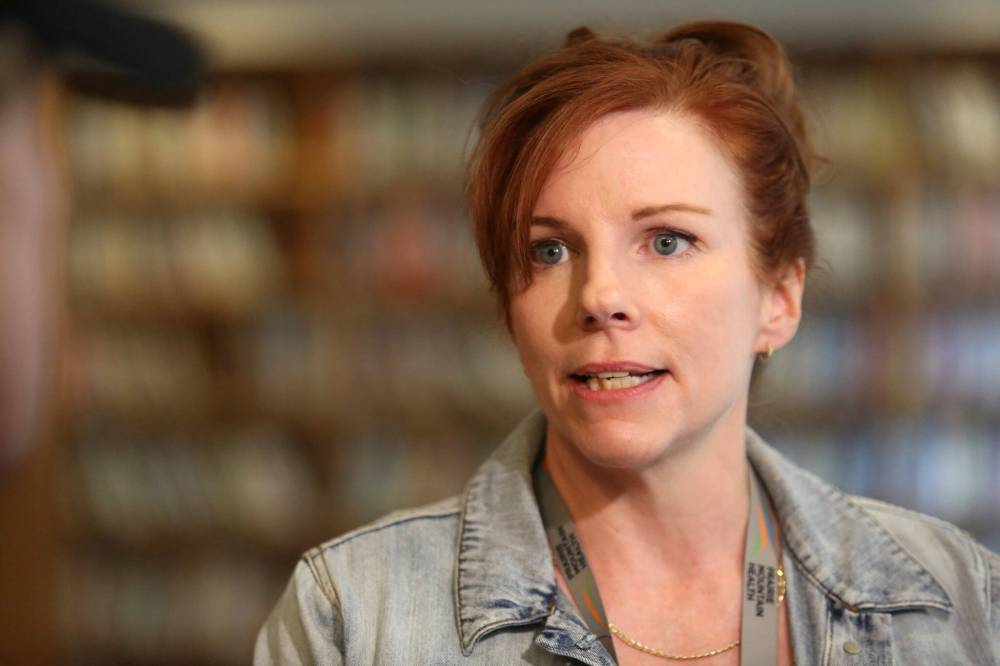When Brandon’s hospital was under an emergency Code Orange after the multi-fatality crash near Carberry on Thursday, it was the largest medical response hospital staff had experienced in at least three decades.
Physicians, nurses, pharmacists, diagnostic imaging technicians, and numerous other health-care workers were on high alert when the call came to Brandon Regional Health Centre (BRHC) about the incoming patients, said Treena Slate, regional lead acute care and chief nursing officer with Prairie Mountain Health (PMH).
“Because we had time to prepare, we were able to ensure that we had capacity in our operating rooms and our intensive care unit, where we knew we might have to accept patients following the emergency department. So, we ensured that we had capacity in those areas,” Slate said.
 ‘>
‘>Prairie Mountain Health CEO Brian Schoonbaert speaks with media during the press conference. Schoonbaert confirmed that Thursday afternoon’s deadly collision near Carberry between a semi-truck and a small bus, and the hospital’s use of a Code Orange as a result, represented the largest single incident response the hospital has faced in at least three decades.
Slate, who said she has been with BRHC for more than 20 years, and Brian Schoonbaert, the CEO of PMH, who has more than 30 years with the health region, agreed it was the largest medical response situation the hospital has ever seen.
“Not of this magnitude, and not of this severity,” Schoonbaert said.
When a Code Orange is called because of mass casualties, teams from all facilities in the health region are on standby, and depending on the need, a decision would be made whether to send staff from a neighbouring hospital or clinic to Brandon, or have staff within the health facility take on a different role.
“It’s like a hive mentality where everybody is thinking as one and responding as one,” said Schoonbaert. “We wish we didn’t have to do these things. But I think what’s important to know is that when it is needed it’s available by a very competent team.”
Thursday’s fatal crash on the Trans-Canada Highway at the intersection of Highway 5 near Carberry took the lives of 15 seniors from Dauphin, who were on their way to the Sandhills Casino when their bus collided with a semi-trailer.
There are 10 survivors who range in age from their early 60s to late 80s, and all are being cared for by teams at BRHC and Winnipeg’s Health Sciences Centre (HSC), according to an update provided on the Shared Health website.
Of those patients, six are in a critical care unit and four are being cared for in a surgical unit.
One patient is in BRHC recovering in a surgical unit, Dr. Shawn Young, chief operating officer of HSC Winnipeg, told the Sun during a phone interview on Friday.
Responding to the crash site on Thursday were 13 ambulances and support crews from PMH, Southern Health and Shared Health as well as two STARS helicopters, one being from Regina, Sask.
Additionally, 30 paramedics responded along with police and fire from Brandon, Carberry, with patient air-transfers handled by the two helicopters, four planes including one from Saskatchewan, and various other ground transportation, according to information disclosed at a Shared Health news conference from Winnipeg on Friday.
During the original transfer of patients, half a dozen were initially sent to BRHC Shared Health CEO Lanette Siragusa said in a phone interview with the Sun on Friday.
“Two went to Portage la Prairie from the scene, two went to HSC from the scene, and six went to Brandon from the scene. And then, of those six [from Brandon], five were sent to HSC, as well as the two patients from Portage,” Siragusa said.
The scheduled procedures in the Brandon hospital’s operating rooms were postponed during the Code Orange, but that wasn’t necessary, said Slate.

Trena Slate, the regional lead acute care and chief nursing officer for Prairie Mountain Health, offers a description of what happens during a Code Orange alert at the Brandon Regional Health Centre during a press conference on Friday afternoon. (Matt Goerzen/The Brandon Sun)
“Everything happened in the emergency department, so we stabilized our patients who came here and then the STARS team came on site, assessed the patients and transported them expediently.”
There is no concern with BRHC being able to handle many emergency cases at once, said Schoonbaert, and the hospital’s capability is not related to the transfer of patients to HSC in Winnipeg.
“We do act as a province when it comes to trauma. So, if there is a head or back injury, or multiple fractures, it is better that they be transferred to Winnipeg to their trauma centre, which is the one in the province. And it doesn’t mean that we can’t be the first to do the assessment and treatment, which is exactly what happened yesterday,” said Schoonbaert.
There was also a backup plan in place in case an emergency call came in from another area in the region, while all emergency workers, responders and vehicles were at the scene of the crash, said Dr. Rob Grierson, Shared Health’s chief medical officer of emergency response services.
“Other facilities such as Neepawa, Virden and Souris would have taken some other 911 response patients. So, in the region, there would have been patients that might have been taken to Brandon, and if it was a primary 911 call, we would have distributed those patients accordingly based on their condition to other facilities to free up the staff in Brandon,” said Grierson.
The Code Orange lasted about three hours, and according to Schoonbaert and Slate it went “really well.”
They have already met with emergency department staff, and next week will debrief with additional teams at the hospital, to see if there are any changes needed to be made for next time.
» Twitter: @enviromichele
